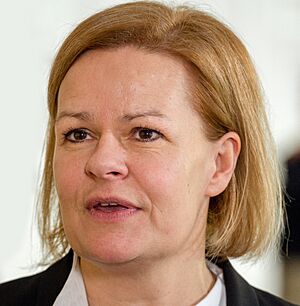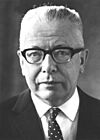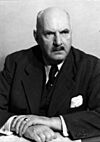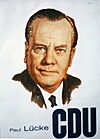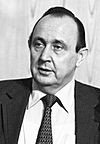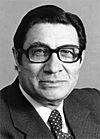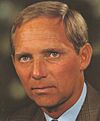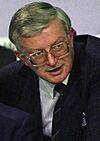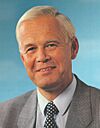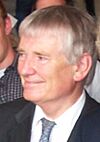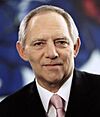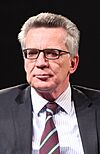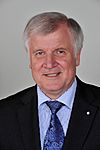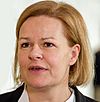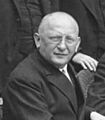List of German interior ministers facts for kids
Quick facts for kids Federal Minister of the Interior |
|
|---|---|

|
|
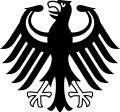
|
|
| Federal Ministry of the Interior | |
| Style | Frau Bundesminister |
| Member of | Cabinet |
| Reports to | Chancellor of Germany |
| Seat | Alt-Moabit 140, Berlin |
| Appointer | The President
on advice of the Chancellor
|
| Formation | 21 December 1879 |
| First holder | Karl von Hofmann |
The Federal Minister of the Interior (in German: Bundesminister des Innern) is a very important job in the German government. This person is the leader of the Federal Ministry of the Interior. They are also a member of the Cabinet, which is like the main team of ministers who help the Chancellor run the country.
Contents
What Does the Interior Minister Do?
The Federal Minister of the Interior is in charge of many things that affect people's daily lives in Germany. Their main job is to keep Germany safe and organized. This includes looking after national security, which means protecting the country from threats.
They also manage public order, making sure laws are followed and people are safe. This minister oversees the police forces and other security agencies. They are also responsible for things like civil protection, which helps people during emergencies or disasters.
Another big part of their role is managing immigration and citizenship. This means dealing with people coming into Germany and helping them become citizens. They also handle sports and building matters for the government.
Who is the Current Minister?
The person currently holding this important role is Nancy Faeser. She became the Federal Minister of the Interior on December 8, 2021. She works closely with the Chancellor and other ministers to make sure Germany runs smoothly and safely.
A Look Back in Time
The role of the Interior Minister has changed a lot throughout German history. It started way back in 1879. Over the years, many different people have held this position. Each minister played a part in shaping Germany's laws and how the country was governed during their time.
During different periods, like the time before World War I, the Weimar Republic, and even during the time of East Germany (GDR), there were people in charge of similar tasks. Their responsibilities often reflected the challenges and needs of Germany at that specific time.
Ministers Since 1949
After World War II, when modern Germany (the Federal Republic of Germany) was formed in 1949, the role of the Federal Minister of the Interior became what it is today. Since then, many different people have served in this position, helping to build and protect the country.
Political Party: CDU CSU FDP SPD
| No. | Portrait | Minister of the Interior | Took office | Left office | Time in office | Party | Cabinet |
|---|---|---|---|---|---|---|---|
| 1 | Gustav Heinemann (1899–1976) |
20 September 1949 | 11 October 1950 | 1 year, 21 days | CDU | Adenauer I | |
| 2 | Robert Lehr (1883–1956) |
11 October 1950 | 20 October 1953 | 3 years, 9 days | CDU | Adenauer I | |
| 3 | Gerhard Schröder (1910–1989) |
20 October 1953 | 13 November 1961 | 8 years, 24 days | CDU | Adenauer II–III | |
| 4 | Hermann Höcherl (1912–1989) |
14 November 1961 | 25 October 1965 | 3 years, 345 days | CSU | Adenauer IV–V Erhard I |
|
| 5 | Paul Lücke (1914–1976) |
26 October 1965 | 2 April 1968 | 2 years, 159 days | CDU | Erhard II Kiesinger |
|
| 6 | Ernst Benda (1925–2009) |
2 April 1968 | 21 October 1969 | 1 year, 202 days | CDU | Kiesinger | |
| 7 | Hans-Dietrich Genscher (1927–2016) |
22 October 1969 | 16 May 1974 | 4 years, 216 days | FDP | Brandt I–II | |
| 8 | Werner Maihofer (1918–2009) |
16 May 1974 | 8 June 1978 | 4 years, 23 days | FDP | Schmidt I–II | |
| 9 | Gerhart Baum (born 1932) |
8 June 1978 | 17 September 1982 | 4 years, 101 days | FDP | Schmidt II–III | |
| 10 | Jürgen Schmude (born 1936) |
17 September 1982 | 1 October 1982 | 14 days | SPD | Schmidt III | |
| 11 | Friedrich Zimmermann (1925–2012) |
4 October 1982 | 21 April 1989 | 6 years, 199 days | CSU | Kohl I–II–III | |
| 12 | Wolfgang Schäuble (1942–2023) |
21 April 1989 | 26 November 1991 | 2 years, 219 days | CDU | Kohl III–IV | |
| 13 | Rudolf Seiters (born 1937) |
26 November 1991 | 7 July 1993 | 1 year, 223 days | CDU | Kohl IV | |
| 14 | Manfred Kanther (born 1939) |
7 July 1993 | 27 October 1998 | 5 years, 112 days | CDU | Kohl IV–V | |
| 15 | Otto Schily (born 1932) |
27 October 1998 | 22 November 2005 | 7 years, 26 days | SPD | Schröder I–II | |
| 16 (12) |
Wolfgang Schäuble (1942–2023) |
22 November 2005 | 28 October 2009 | 3 years, 340 days | CDU | Merkel I | |
| 17 | Thomas de Maizière (born 1954) |
28 October 2009 | 3 March 2011 | 1 year, 126 days | CDU | Merkel II | |
| 18 | Hans-Peter Friedrich (born 1957) |
3 March 2011 | 17 December 2013 | 2 years, 289 days | CSU | Merkel II | |
| 19 (17) |
Thomas de Maizière (born 1954) |
17 December 2013 | 14 March 2018 | 4 years, 87 days | CDU | Merkel III | |
| 20 | Horst Seehofer (born 1949) |
14 March 2018 | 8 December 2021 | 3 years, 269 days | CSU | Merkel IV | |
| 21 | Nancy Faeser (born 1970) |
8 December 2021 | Incumbent | 3 years, 364 days | SPD | Scholz |
Images for kids


